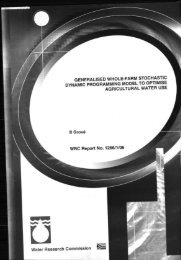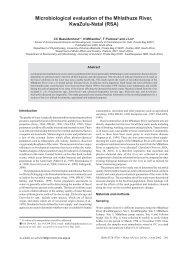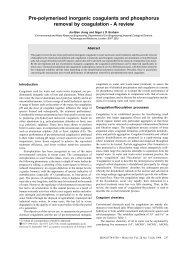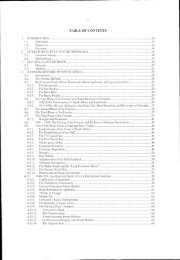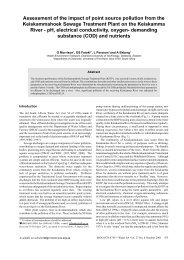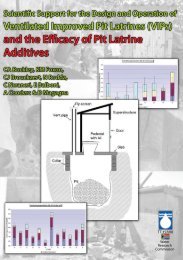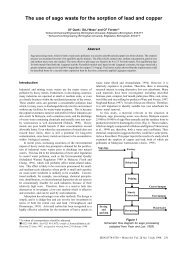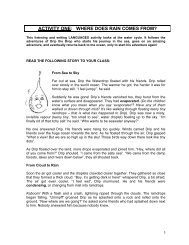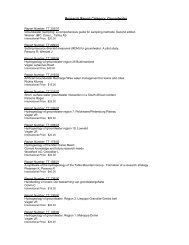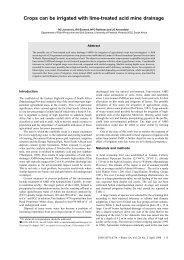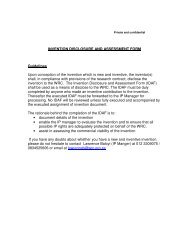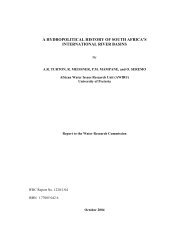A Methods Manual for the Collection, Preparation and Analysis of ...
A Methods Manual for the Collection, Preparation and Analysis of ...
A Methods Manual for the Collection, Preparation and Analysis of ...
You also want an ePaper? Increase the reach of your titles
YUMPU automatically turns print PDFs into web optimized ePapers that Google loves.
2.3.2 Examination <strong>of</strong> fresh material <strong>and</strong> extraction <strong>of</strong> diatoms <strong>for</strong> acidtreatmentThe living, motile component <strong>of</strong> <strong>the</strong> sampled diatom population may be extracted <strong>and</strong>separated in <strong>the</strong> following manner: The fresh sediment/diatom mix is spread over <strong>the</strong> bottom <strong>of</strong> a petri dish or flat-bottomedplastic tray <strong>and</strong> <strong>the</strong> heavier sediment is allowed to settle <strong>for</strong> a few hours (e.g. overnight). The following day <strong>the</strong> excess supernatant is drained from <strong>the</strong> petri dish until <strong>the</strong> moistsediment is exposed. Several coverslips are allowed to gently ‘float’ <strong>and</strong> rest on <strong>the</strong> damp sediments <strong>for</strong> a 4hour period <strong>of</strong> exposure to natural light. The coverslips are <strong>the</strong>n carefully removed <strong>and</strong> gently rinsed to remove unwanted s<strong>and</strong>particles. The coverslips are placed on a clean slide <strong>for</strong> examination <strong>of</strong> diatom cells.2.3.2.1 Alternative separation techniques Tissue paperIf <strong>the</strong> original sample contains large s<strong>and</strong> grains, it is advisable to place tissue paper between<strong>the</strong> coverslip <strong>and</strong> <strong>the</strong> sediment. This allows <strong>the</strong> passage <strong>of</strong> <strong>the</strong> motile diatoms on to <strong>the</strong>coverslip but prevents <strong>the</strong> transfer <strong>of</strong> unwanted sediment grains to <strong>the</strong> slide. Submersed coverslipsIt is not necessary to remove all <strong>the</strong> supernatant from <strong>the</strong> fresh material if living diatoms arenot required <strong>for</strong> initial examination. Coverslips are submerged <strong>and</strong> ‘floated’ on to <strong>the</strong>sediment/diatom mix after <strong>the</strong> material has settled in a tray / petri dish. Living diatomsactively adhere to <strong>the</strong> surface <strong>of</strong> <strong>the</strong> coverslip under <strong>the</strong> water. This technique ensures thats<strong>and</strong> grains are washed <strong>of</strong>f <strong>the</strong> coverslips as <strong>the</strong>y are carefully withdrawn <strong>and</strong> placed in asample bottle containing ethanol <strong>for</strong> preservation or allowed to air dry <strong>for</strong> acid treatment.2.4 PhytoplanktonPhytoplankton sampling can be achieved in one <strong>of</strong> two ways. The most simple method is tocollect water in a two litre container, add preservative (Lugol’s iodine), <strong>and</strong> allow <strong>the</strong> deadplanktonic organisms to settle out. The sedimentation rate <strong>of</strong> most phytoplankton allows <strong>for</strong>complete settling within 16-24 hours from a two litre measuring cylinder.Alternatively a plankton net may be used with a mesh size <strong>of</strong> not more than 25 µm. Theplankton net should be dragged back <strong>and</strong> <strong>for</strong>th just below <strong>the</strong> surface <strong>of</strong> st<strong>and</strong>ing waters orheld in <strong>the</strong> stream <strong>of</strong> moving waters <strong>for</strong> a few minutes. This should allow <strong>for</strong> <strong>the</strong> collection <strong>of</strong>15



